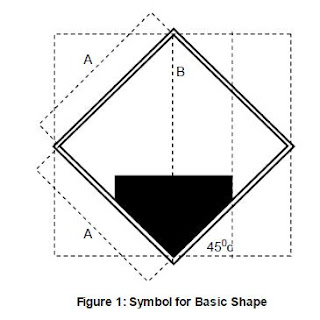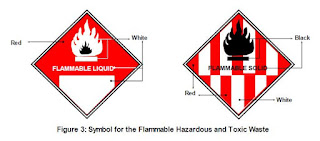Chemical Hazard Symbol is regulate by government and International standard to indicate the content of any container that transport that material. The regulation of chemical hazard symbol in Indonesia is made by Ministry of Environment and become update if any changes. Some of symbol of chemical hazard is shown on the picture below.
Basic Shape, Size, Materials:
The length of the lines making the points should be 1/3 of the height of the diamond and the width of the base should be 1/2 the length of the diamond side.
Explosives, Hazardous and Toxic Chemicals
Flammable Chemicals:
There are two kind of these symbol type, Flammable liquid and Flammable Solid.
Symbol of Reactive Hazardous Chemicals:
Symbol for Toxic Waste:
This is symbol that using International standard, every symbol in the plant should follow the regulation of the above size and dimension already stated by regulation. There are small symbol and big symbol of each chemical characteristic already stated by regulation, local and international. If you make other kind symbol either dimension and size or other symbol that is not include in the regulation, you must change with the stated symbol. You can make statement other than symbol by your word but for symbol already state on the regulation.
Other Related Article:
Basic Shape, Size, Materials:
The length of the lines making the points should be 1/3 of the height of the diamond and the width of the base should be 1/2 the length of the diamond side.
Flammable Chemicals:
There are two kind of these symbol type, Flammable liquid and Flammable Solid.
Symbol of Reactive Hazardous Chemicals:
This is symbol that using International standard, every symbol in the plant should follow the regulation of the above size and dimension already stated by regulation. There are small symbol and big symbol of each chemical characteristic already stated by regulation, local and international. If you make other kind symbol either dimension and size or other symbol that is not include in the regulation, you must change with the stated symbol. You can make statement other than symbol by your word but for symbol already state on the regulation.
Other Related Article:




Comments